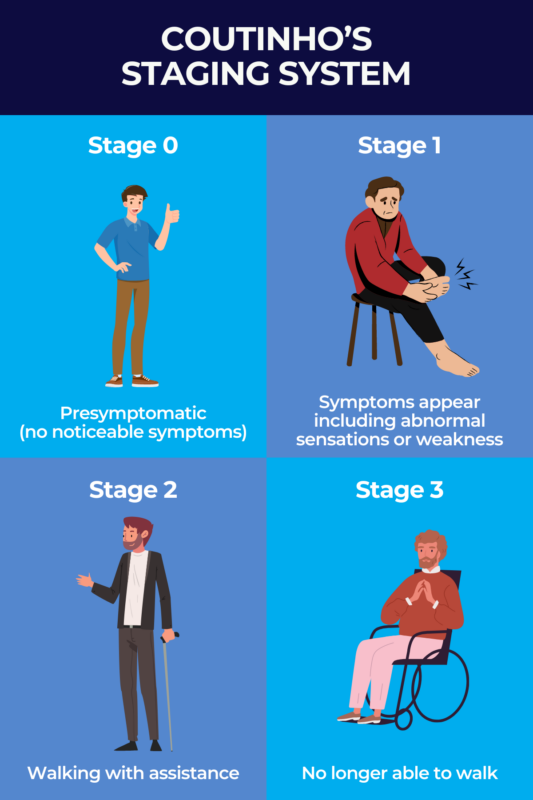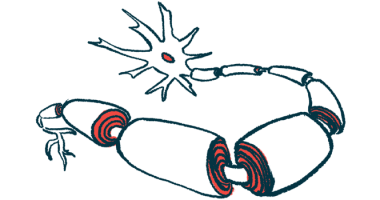Understanding the FAP staging system
Last updated March 14, 2024, by Marisa Wexler, MS

Familial amyloid polyneuropathy (FAP) is a genetic disorder that causes nerve damage. It results in symptoms including difficulty walking, numbness, and abnormal sensations. Staging systems are used to track FAP progression and help determine treatment.
What are FAP staging systems?
FAP is mainly caused by mutations in the TTR gene, leading to toxic clumps of the protein transthyretin, which can damage nerves. It is a progressive disease, which means symptoms are usually mild when they first appear and then gradually worsen over time. FAP symptoms usually are first felt in the feet and then start to affect other parts of the body.
Specific symptoms of FAP, the timing of when they appear, and how quickly they progress vary greatly from person to person.
Staging systems are generalized frameworks used to track the progression from early-stage FAP to advanced FAP, but the progression of FAP stages affects each person differently. A person with FAP can work with their healthcare providers to better understand their particular stage and how this may affect FAP prognosis.
In addition to helping track disease progression, FAP stages also are important for decisions about treatment strategies. In particular, Coutinho’s staging system is used to determine eligibility for several approved FAP treatments.
Coutinho’s staging system
The main system used to define FAP disease stages is Coutinho’s system, named for one of the scientists who pioneered it in the early 1980s. When discussing stages of FAP, people are usually referring to this system specifically.
Coutinho’s system divides FAP into four stages based mainly on how the disease affects the ability to walk.
- Stage 0, the first stage of FAP, is presymptomatic. A disease-causing TTR mutation has been identified and medical tests may show toxic protein clumps, but there are no noticeable symptoms of nerve damage.
- Stage 1 is the first stage where symptoms appear. In stage 1 FAP, there may be some symptoms, such as abnormal sensations, numbness, or weakness, but they are generally mild and mostly occur in the feet. Walking without assistance is still possible.
- In stage 2, an aid such as a crutch or cane is needed to be able to walk. Generally, symptoms are moderate, affecting the hands, arms, and torso, in addition to the feet and legs.
- Stage 3, the final FAP stage, is when a wheelchair is needed to get around and movement is extremely limited, such as getting out of bed without assistance. Symptoms are typically severe and affect the entire body.

Polyneuropathy disability scoring system
The polyneuropathy disability scoring system offers a slightly more detailed approach than Coutinho’s system, classifying the severity of FAP symptoms in six stages based mainly on how walking is affected.
- In stage 0, signs of disease may be detectable on medical tests, but there aren’t any noticeable symptoms.
- In stage 1, there are noticeable symptoms, such as abnormal sensations, but no difficulty walking.
- In stage 2, walking is noticeably affected, but still possible unassisted.
- In stage 3a, an aid such as a crutch or cane is needed to walk, but only on one side of the body.
- In stage 3b, a walking aid that supports both sides of the body is needed.
- In stage 4, if able to use, a wheelchair is needed to get around.
Portuguese classification system
Another alternative for staging FAP is the Portuguese classification system, which divides the disease into seven levels based on symptoms as well as signs of nerve damage.
- Level 0: no symptoms or nerve damage
- Level 1: some mild symptoms, but no detectable nerve damage
- Level 2: the first detectable signs of damage to nerves involved in sensation
- Level 3: damage to nerves needed for movement is evident in the legs, but still able to walk independently
- Level 4: damage to nerves (sensitive or motor) detectable in the arms as well as legs, walking independently possible
- Level 5: a wheelchair is needed to get around
- Level 6: patients bedridden.
Treatment and management
Education on how to recognize the early stages of FAP is important so that treatment can begin as soon as symptoms are noticeable.
Once symptoms appear and a FAP diagnosis is confirmed, treatment is usually begun with medications to slow the progression of the disease and help relieve symptoms.
Some medicines for FAP treatment are indicated for everyone with the disease, while others are specifically indicated for certain disease stages. Working with a care team can help someone with FAP understand what therapies are available and appropriate in their specific situation.
In addition to medications, supportive interventions including physical and occupational therapy can help navigate living with FAP and improve quality of life.
Because the transthyretin protein is mainly produced in the liver, a liver transplant is another possible option in some cases.
FAP News Today is strictly a news and information website about the disease. It does not provide medical advice, diagnosis, or treatment. This content is not intended to be a substitute for professional medical advice, diagnosis, or treatment. Always seek the advice of your physician or other qualified health provider with any questions you may have regarding a medical condition. Never disregard professional medical advice or delay in seeking it because of something you have read on this website.
Recent Posts
Related articles






